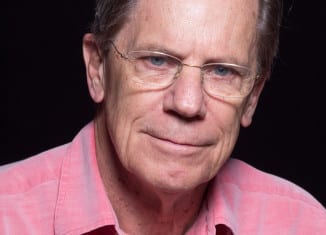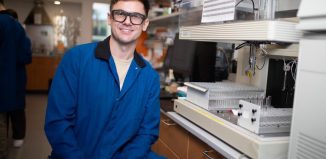CSHL’s Fearon works on way to help immune system fight cancer
Determined to help develop better treatments and, perhaps even a cure, Douglas Fearon, a medical doctor, decided to conduct research instead of turning to existing remedies. More than two decades later, Fearon joined Cold Spring Harbor Laboratory and is working on ways to help bodies afflicted with cancer heal themselves.
Fearon is focusing on the battle cancer wages with the T lymphocytes cells of human immune systems. Typically, these cells recognize threats to human health and destroy them. The pancreatic cancer cells he’s studying, however, have a protective mechanism that is almost like a shield. “The cancer is killing the T cells before the T cells can kill the cancer,” said Fearon.
The T cells have a complex signaling pathway on their surface that allows them to link up with other objects to determine whether these cells are friend or foe. In pancreatic cancer, Fearon has focused on a receptor that, when attached to the deadly disease, may disarm the T cell.
Researchers had already developed a small molecule that blocks the receptor on the T lymphocytes from linking up with this protein for another disease: the human immunodeficiency virus. When Fearon applied this molecule to a mouse model of pancreatic cancer, the therapy showed promise. “Within 24 hours, T cells were infiltrating the cancer cells,” he said. “Within 48 hours, the tumors had shrunk by 15 percent. This drug overcame the means by which cancer cells were escaping.”
This month, doctors at the University of Cambridge School of Clinical Medicine, where Fearon worked for 20 years, plan to begin Phase I human trials of this treatment for pancreatic cancer. Later this year, doctors at the Weill Cornell Medical College in New York City, where Fearon has a joint appointment, will begin a similar effort.
Scientists are encouraged by the early results from Fearon’s treatment. The Lustgarten Foundation named Fearon one of three inaugural “Distinguished Scholars” last year, awarding him $5 million for his research over the next five years.
The scientific advisory board at the Foundation “expects distinguished scholars to be on the leading edge of breakthrough therapies and understanding for this disease,” said David Tuveson, a professor and director of the Lustgarten Foundation Pancreatic Cancer Center Research Laboratory at CSHL.
During the early stage trials, doctors will increase the dosage to a level HIV patients had received during early experiments with the drug, called AMD 3100 or Plerixafor.
While Fearon is cautiously optimistic about this approach, he recognizes that there are many unknowns in developing this type of therapy. For starters, even if the treatment is effective, he doesn’t know whether the cancer may recur and, if it does, whether it might adapt some way to foil the immune system’s attempt to eradicate it.
Additionally, the receptor the doctors are blocking is required for many other functions in humans and mice. In mice, for example, the receptor on the T cell has a role in the developing nervous system and it also plays a part in a process called chemotaxis, which directs the migration of a cell.
“After giving this drug to HIV patients for 10 days, there were no long-term effects,” Fearon said. Researchers and doctors don’t “know for sure if you continued blocking this receptor what the long-term effects” would be.
Fearon and his wife Clare are renting a cottage in Lloyd Neck and have an apartment on the Upper East Side. Their daughter Elizabeth recently earned her Ph.D. in epidemiology in Cambridge, England while their son Tom, who is working toward a graduate degree in psychology, is interested in a career in counseling.
A native of Park Slope, Brooklyn who was the starting quarterback for Williams College in Massachusetts in his junior and senior years, Fearon feels it’s a “privilege to do something that may have a positive effect” on people’s lives.
Fearon is especially pleased to work at CSHL, where he said he can collaborate with colleagues who often immediately see the benefits of such a partnership. He has worked with Mikala Egeblad on intravital imaging, which is a type of microscope that allows him to look at living tissue. They are sharing the cost of buying a new instrument. Working with her “facilitated my ability to start up a project in my lab using a similar technique,” Fearon said.







